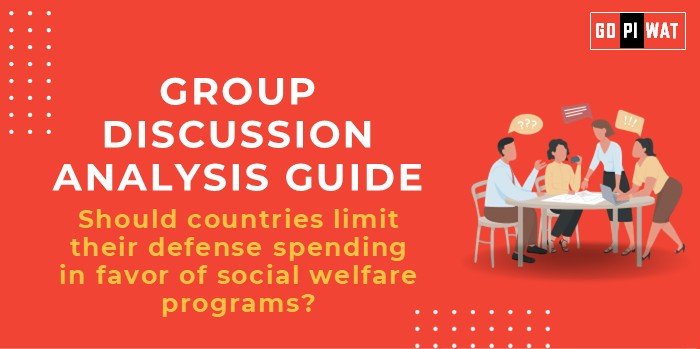📋 Group Discussion (GD) Analysis Guide
🌐 Topic: Should Countries Limit Their Defense Spending in Favor of Social Welfare Programs?
🌟 Introduction
- Opening Context:
“Global priorities often hinge on the delicate balance between national security and social welfare. In an era of rising global tensions and economic disparities, this debate has become more urgent than ever.” - Background:
The rise in global military expenditures to a record $2.44 trillion in 2023 highlights growing geopolitical tensions. Simultaneously, nations like those in the Nordic region demonstrate the benefits of prioritizing social welfare. This duality underscores the critical trade-offs policymakers must navigate.
📊 Quick Facts & Key Statistics
- 💰 Global Military Expenditure (2023): $2.44 trillion, a 6.8% increase from 2022.
- 🏡 Social Spending in Nordic Countries: 25–30% of GDP leads to high living standards and low poverty rates.
- 🛡️ India’s Defense Budget (2024): ₹6.21 lakh crore ($75 billion), 13% of total expenditure.
- 📉 UNDP Report (2023): Excessive military spending risks diverting resources from social services, hindering human development.
🧑🤝🧑 Stakeholders and Their Roles
- 🏛️ Governments: Balance defense and welfare allocations to meet strategic and social needs.
- 🌍 International Organizations: Advocate for peace and sustainable development (e.g., UN, WHO).
- 🌟 Civil Society: Push for transparency and increased investments in human development.
- ⚙️ Military-Industrial Complex: Drives technological innovation but consumes significant resources.
🏆 Achievements and Challenges
🎉 Achievements:
- 🌐 Global Stability: Increased defense spending has deterred conflicts in volatile regions.
- 🔬 Technological Advancements: Defense research fosters innovations with civilian applications.
- 👨👩👧👦 Welfare Models: Nordic nations demonstrate the efficacy of investing in human capital.
⚠️ Challenges:
- 🔄 Resource Misallocation: Diverts funds from essential services like health and education.
- ⚖️ Economic Inequality: Countries with high defense budgets often face social inequities.
- 🔥 Security Dilemmas: Military spending can fuel arms races, exacerbating global tensions.
🌍 Global Comparisons:
- 🇺🇸 USA: High defense spending supports economic growth but challenges welfare priorities.
- 🇳🇴 Nordic Countries: Welfare-centric models promote equity and economic stability.
- 🇮🇳 India: Balances substantial defense needs with flagship welfare programs like MGNREGA.
- 🇯🇵 Japan: Maintains a welfare focus with minimal defense expenditure.
🗣️ Effective Discussion Approaches
📌 Opening Approaches:
- 📊 Highlight the record $2.44 trillion global military expenditure.
- ⚖️ Contrast defense-heavy nations like the US with welfare-focused Nordic countries.
🎭 Counter-Argument Handling:
- Use examples like Japan to show the feasibility of welfare prioritization.
- Refer to the UNDP report emphasizing human development over defense escalation.
🔍 Strategic Analysis of Strengths & Weaknesses
- ✅ Strengths: Technological progress and geopolitical stability from defense investments.
- ❌ Weaknesses: Opportunity costs and the ethical implications of high military spending.
- 📈 Opportunities: Redirection of resources to education, healthcare, and infrastructure.
- ⚠️ Threats: Increasing global conflicts and security dilemmas.
📖 Structured Arguments for Discussion
- ✅ Supporting Stance: “Redirecting defense funds to welfare enhances human capital and fosters long-term stability.”
- ❌ Opposing Stance: “Defense spending is vital for sovereignty and deterrence in an increasingly volatile world.”
- ⚖️ Balanced Perspective: “A calibrated approach, balancing defense and welfare, can address both immediate and long-term goals.”
🎓 Connecting with B-School Applications
- 📘 Real-World Applications:
- Strategy in managing budgetary trade-offs.
- Insights into global leadership and governance challenges.
- 📋 Sample Questions:
- “What lessons can be learned from Nordic welfare systems?”
- “How can public-private partnerships help balance defense and welfare spending?”
- 💡 Insights for Students:
- Leverage fiscal strategies for operations and finance.
- Explore dual-use technologies to address both defense and welfare goals.


